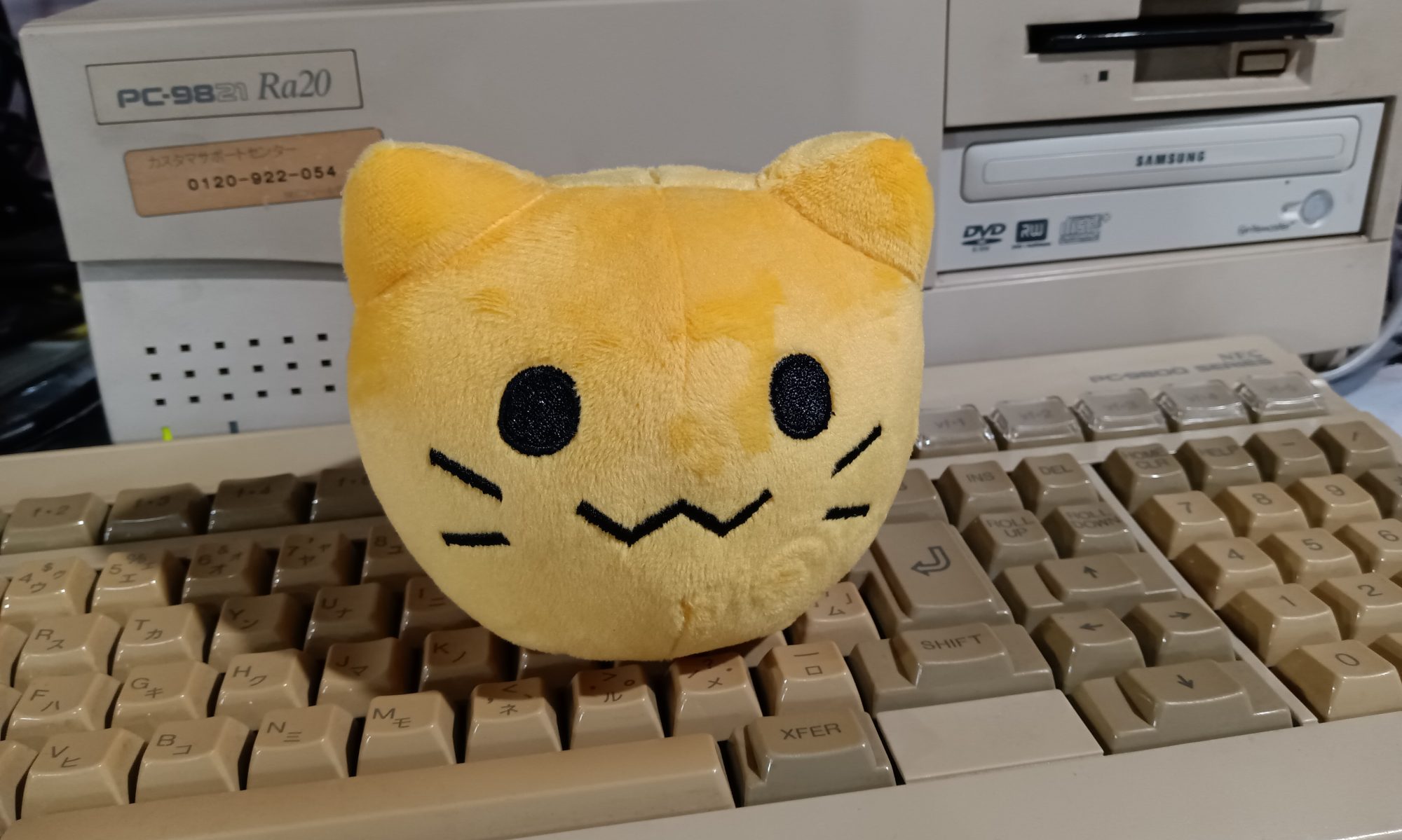While I was sharing the classic “why Mastodon is big in Japan” article around to prove a point again about the early days of the fediverse and who actually uses the fediverse as opposed to who says they want to use the fediverse, I noticed yet again something I had never written about the fediverse in depth before. Namely; there are two major camps on the fediverse that are mutually incompatible and have widely different mindsets, giving the effect that there are two fediverses on the same network. Most of my posts on the fediverse and fediverse meta talk about this, but as I haven’t written a post solely on this (for linking purposes) I might as well do so for the future.
One of the largest complaints about “the fediverse” right now comes down to the fact that the network is visibly fragmented. Instance blocking has become one of the most abused features of software stacks (or instance software as it’s called) on the fediverse. Instances will defederate each other or individual users for the stupidest of reasons, instance owners will lock down APIs so you can’t even see who is blocking who, and of course trying to negotiate with them is near impossible.
The walled garden vs the federation
The first thing to understand why this is the case comes down to the design philosophies of social networks. The previous generations of social networks are commonly called “walled gardens” due to both the monolithic design of these websites and how they are designed to be the one place to go online. This is in reference to the architecture of AOL (and CompuServe, Prodigy, etc.) with a closed system of message boards, file hosting, and more all for users who paid for it. Just like today, these walled gardens had the same moderation scandals too, with at least one hacker creating a skid tool to protest AOL banning his account for asking why the child abusers aren’t banned.
While these died off for a time period, they came back with a vengeance when internet companies consolidated and users began to use a site like Facebook to do everything. Even as Facebook’s popularity declines, it’s still notable for both being where boomers talk and Facebook Marketplace basically replacing Craigslist in the eyes of some normies. In China the situation is even more extreme, with WeChat being notorious for not only being used for chatting but also social media and payments. Elon Musk has seen this as his end game for Twitter as well, renaming the app to X in order to also eventually provide payments to become the “WeChat of the west“. Of course, this is highly unlikely given that Elon Musk manages to piss off powerful lobbies every other week seemingly, but I’m sure Mark Zuckerberg or Tim Cook would be happy to take his place as an “everything app” developer.
But one of the things these walled gardens are famous for is having moderation policies that get stronger and more toleration every month, chasing the dragon of having a website with “no bad people”. As a result, a lot of people now want a heavily moderated website and cannot exist outside a bubble in which strong moderation tools are present. This is important to remember, and it’ll explain why the fedi has the users it does.
The federation architecture on the other hand used by ActivityPub and others has been compared to email for a good reason, email functions as such a network as well. You can send emails to anyone, and receive them. This is all in theory of course, as due to spam you can find yourself in the situation of having to be unlisted by the Google cartel. Many just give up and end up having to use Gmail or Outlook/Exchange anyway. But in an ideal world, you can send and receive emails to anyone, and this is supposed to be the idea of the fediverse too.
The sides of the fedi
The problem is that in the current year everything has to be split down the middle. The reality is, there are two different fediverses using the same protocol. In theory they can communicate with each other, but one side does not want the other to communicate (and sometimes both sides, depending on where you post).
You might assume these sides are split politically and you’d be half right, one side is essentially a left-wing spectrum ranging from “catlady with MoveOn.org, =, and Bernie stickers all over her Chevy Spark permanently tuned to NPR” to “crazy former Tumblr user” and everyone in between, with the other being everyone else. There’s also tons and tons of infighting in these sides. An instance that has been blocked by everyone online for “loli” will also block some instances that might be “chuds”, a trans instance blocked by everyone will block the only people who want to talk to them for being *phobic and then cry about no activity, and instances blocking each other in the left wing side for arguments are great examples.
But the truth is one side is about freedom of speech, one side is about building a larger and finer tuned hugbox, and you tend to end up on either side naturally depending on who you talk to. It’s not like you have a choice. One day you will notice posts quit showing up from someone you follow, you’re completely unfollowed from someone, and when you click follow you get “request sent”. None of their new posts will show up, and if they move instances they have a chance of being blocked. Hell, even if they self-host they might be blocked by some schizophrenic instance owner for “No TOS” or some stupid rule like that.
Welcome to the world of having two networks speaking the same language, with the barrier put up existing only thanks to mass hysteria.
And just like the culture war, it doesn’t matter where you go. You can run, you can hide, but you will always find yourself having to deal with the reality of this.
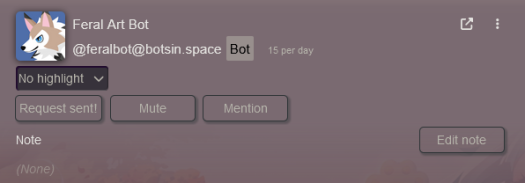
The Mastodon Network™ side
One side of the fediverse I’m going to call the Mastodon Network side. Now this name is actually somewhat misleading, a lot of the instances on this side do not run Mastodon (or its forks such as glitch-soc, hometown, etc.) but rather forks of Misskey (Firefish), Pleroma (Akkoma), and some software stacks written by adherents of their ideology such as GoToSocial. There are other nicknames you could give this side such as the “Rainbow Curtain”, fediblockers, the “signed fetch cartel” (I’ll explain what these are), and more.
But the reason I’m calling it this is simple, this is the side that the new users, journalists, and promoters who call the entire network “Mastodon” or “The Mastodon Network” use. It’s heavily marketed with slick PR campaigns on multiple fronts, websites like joinfediverse.wiki or joinmastodon.org will try to steer you to instances with the same rules they enforce, and a Vice article called it “Twitter without the Nazis“. These people also tend to federate with Mastodon.social (think the Facebook or AOL of fediverse), and are on relatively few blocklists.
The idea of the Mastodon Network is simple. The Mastodon Network is designed to be a social network like Twitter, except with more moderation and less harassment. As a result, this is reflected in posts from the users and words of the developers/promoters, github bugs/pull requests, and feature requests. To quote the big in Japan post (which is a look into that mindset some):
The point of decentralized publishing is not censorship resistance – decentralization provides a little resilience to intermediary censorship, but not a lot. Instead, decentralization is important because it allows a community to run under its own rules. One of the challenges for Mastodon is to demonstrate that there are reasons beyond lolicon to run a community under your own rules. This is analogous to a problem Tor faces. People undeniably use Tor to do terrible things online, publishing and accessing hateful content. But Tor is an essential tool for journalists, whistleblowers and activists. It’s a constant struggle for Tor to recruit “everyday” users of Tor, who use the service to evade commercial surveillance. Those users provide valuable “cover traffic”, making it harder to identify whistleblowers who use the service, and political air cover for those who would seek to ban the tool so they can combat child pornography and other illegal content.
Fortunately, there are communities that would greatly benefit from Mastodon: people who’ve grown sick of sexism and harassment on Twitter, but still want the brief, lightweight interaction the site is so good at providing. One of the mysteries of Mastodon is that while many instances were started precisely to provide these alternative spaces, they’ve not grown nearly as fast as those providing space for a subculture banned from Twitter. The Mastodon story so far suggests that sticks may be more powerful than carrots.
Beyond porn, the internet has always provided spaces for content that wasn’t widely acceptable. When it was difficult to find information and LGBTQ lifestyles in rural communities, the internet became a lifeline for queer teens. Distributed social networks are a likely space for conversations about ideas and topics too sensitive to be accepted on centralized social networks, and it’s likely that some of the topics explored will be ones that become more socially acceptable over time.
Oh gee, I wonder why it’s a mystery. It’s not rocket science to anyone who understands the internet though. The thing with the Mastodon Network is, it’s not only trying to be a network for people who aren’t banned from Twitter but it’s even targeting people who are angry that Twitter isn’t banning people fast enough. This is very important to remember every time Mastodon users come up. They want a mythical utopia, where no bad people ever exist, where you can never have to ever see a racial slur online ever again or get told your art sucks. The problem is not only are they not banned from Twitter, but they can only exist in an ecosystem of heavy moderation. Just like how supercars or XXL luxury SUVs tend to vanish from the market when the economy goes down the tubes, trans teens tend to not be found in places with less western influence. Which is the paradox with Mastodon, it’s trying to target people who can only exist in a massive moderation framework.
While they can’t get everyone to comply, they will use their PR platforms to herd the cattle in. joinfediverse.wiki only lists servers that follow a Mastodon written ruleset, isn’t on a blocklist that’s now deleted from the site, and have “strict rules against hate”. A codeberg page tells people to use blocklists and that they must have one in place, but also says that “you should totally know how to moderate first“. One blocklist linked by the page is chosen by “literally this instance blocked it therefore instance bad”. Now imagine that tons of instance owners blindly pull these lists in and you can see why we have a problem. This has led to drama over blocklists as users complain their instance is on there, as posts from users quit showing up or the guy they want to follow stays at “Request Sent” forever.
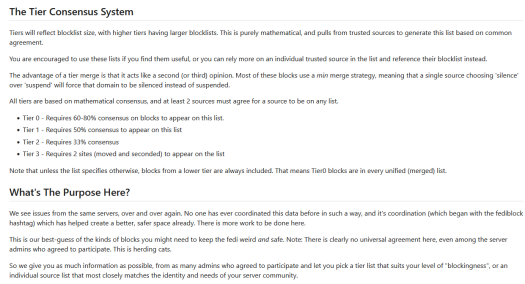
The other problem with blocklists is that they also serve as a weapon to get admins to do whatever they want. Whoever has the blocklist or control of the largest instances has the most power, any instance they block is now invisible to 500k-1m people all with the click of a mouse.
But they don’t stop at blocklists. Case in point, when Gab joined the fediverse and caused massive hysteria (before defederating after their mentality expired), one notorious person wanted Mastodon to literally hardcode a domain block into the code itself.
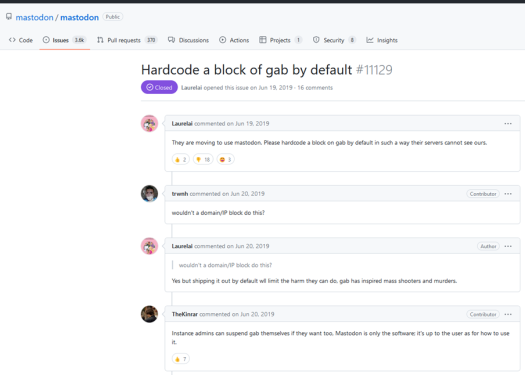
Another example of the Mastodon Network developer mindset as of late comes down to the “signed fetch” issue (or “Authorized Fetch” in the Mastodon world). Essentially, it’s a duct tape “fix” for the problem of federation working a little too well for gangstalking victims which means it has to be broken. To quote @mint:
It adds a header with a signature of internal fetch account to requests coming from your instance so that other instance can check if it’s actually coming from it and not from someone curling the object, and also if your instance is already blocked to deny you from even seeing their posts.
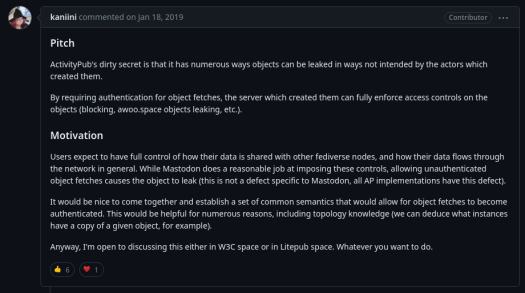
The Mastodon documentation also says it in tech terms, but also straight up explains what the purpose is: control.
As a result, through the authentication mechanism and avoiding re-distribution mechanisms that do not have your server in the loop, it becomes possible to enforce who can and cannot retrieve even public content from your server, e.g. servers whose domains you have blocked.
The end result of signed fetches is utter breakage in reading a thread. It’s very common to see posts where you can only see part of a conversation, with the original post missing, and no notification that the post is unable to be viewed. Why? Because of security theater, that’s what. Aside from being able to see the original post by clicking on “view external post” on the guy replying, there’s also a lot of tricks to bypass this. Even the people pushing for this admit it’s all security theater, and that it can be easily bypassed.

But it’s remarkably effective security theater. GoToSocial, Firefish, Akkoma, and likely some smaller projects all have this on by default or have so many instances using it that many assume they do. In fact, GTS even requires signed fetches causing this Lemmy bug to be open and forcing Lemmy to implement it. Mastodon has it off by default (most of the worst offenders turn it on anyway), with the manuals warning of breakage:
Unfortunately, secure mode is not without its drawbacks, which is why it is not enabled by default. Not all software in the fediverse can support it fully, in particular some functionality will be broken with Mastodon servers older than 3.0; you lose some useful functionality even with up-to-date servers since linked-data signatures are used to make public conversation threads more complete; and because an authentication mechanism on public content means no caching is possible, it comes with an increased computational cost.
And that it’s also theater:
Secure mode does not hide HTML representations of public posts and profiles. HTML is a more lossy format compared to first-class ActivityPub representations or the REST API but it is still a potential vector for scraping content.
But see; here’s the fun part. This is exactly how this cabal gets what they want. Something trying to federate with Akkoma (or “Ackoma” as it’s nicknamed in some freer circles) that has it on by default or GoToSocial (which forces it IIRC) that doesn’t support signed fetches will have users filing bug reports (as shown with the GTS and Lemmy bug report) with “dood it doesn’t federate”. If you hold the line and refuse to implement it or simply don’t get around to it because your friends Mastodon instance doesn’t, well you know the rest:
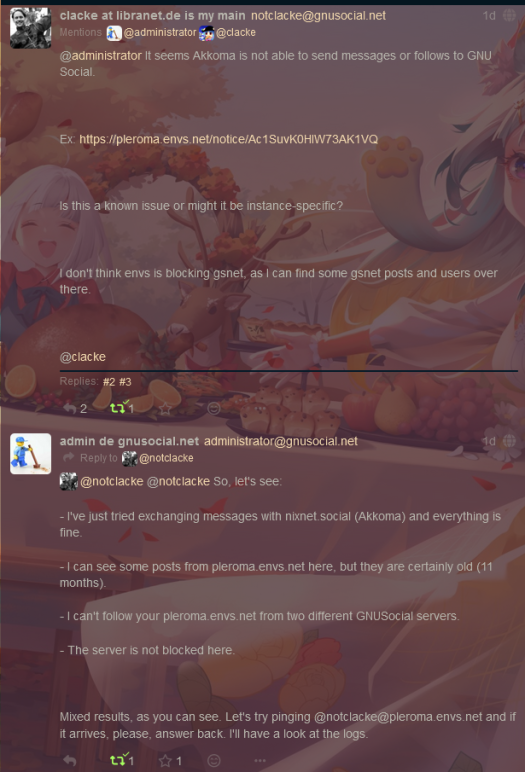
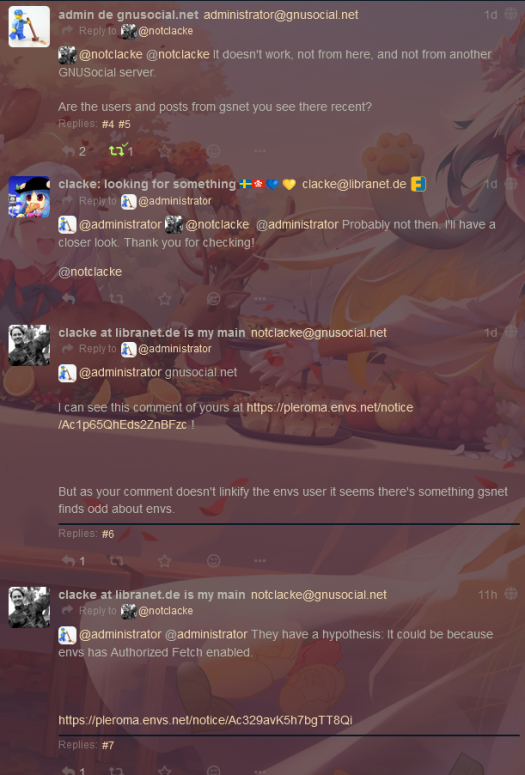
I could go on all day about the “features” or lack of them that have imply Mastodon and that side of the fediverse love security theater. I’m talking post scopes (including hilariously insecure DMs), search deliberately being broken in Mastodon for ages until opt in search was added (leading to this wild meltdown), quote posts not being in Mastodon because of “harassment”, hiding the block lists of servers, it goes on and on.
But the point here is Mastodon users don’t want a federated network as much as they want a federation of allies, and a website that is like “Twitter but stricter rules“. Which is why the experience on these instances comes down to walking on eggshells, finding your entire instance blocked because of something someone else did, and gradually beginning to despise them when you can’t follow artists. But here’s the fun part; there’s a second fediverse.
The “dark fedi”/”alt-fedi”/ex-GNU Social/Pleroma side etc.
The other fediverse consists of literally everyone blocked by these federations of allies, many of which don’t like each other. Quite frankly, this group could be called “everyone else”. Everyone from Neo-Nazi boomers to lolicon enjoyers to schizophrenic trans communists who end up blocked by the main groups of them ends up in this circle. The last group is the most interesting because you’ll see posts from at least one instance crying about being blocked by other trans instances and being labeled as racists online every single day, but also wanting to be deep in the trans community. No, blocking poa.st and writing an essay about how they’re trying to kill you for being trans won’t get you unblocked. There’s also stuff like misskey.io being hard to follow and allegedly blocking people, or something. There are even a few instances on this side of the fediverse like freeatlantis, noagendasocial, and gameliberty that are in fact using Mastodon. There’s also instances on the fringes of this part of the web like Xenofem.me or Disqordia, where no matter how hard they try they will never be a real Mastodon Network instance. They’re only in this side of the fedi not for sharing anything in common, but for being too different to socialize with the other internet commissars, but every bit as bloodthirsty.


Transgender schizophrenics aside, I’m going to focus on the largest overall segment of this (by instances in the Anglosphere), which is a desire for “free speech” or at least “free speech for me” (freespeech.org style, see poa.st as an example). A lot of the time they don’t even say those words, they basically say “yeah do whatever just don’t post illegal shit” or advertise their instance for shitposting. It’s a different part of the fediverse entirely because the community and vibe are massively different. If Mastodon is like walking on eggshells, the “dark fedi” is known for a thunderdome of shitposting, schizophrenic essays, and hodgepodge of many from different backgrounds given a computer and the ability to talk to each other. In some ways it’s pure chaos, but more of an old internet style chaos as opposed to the tightly controlled Mastodon Network instances that advocate for more censorship.
This side of the fedi is like 4chan, an old message board with a group of friends, or a Modern Warfare 2 lobby from 2009 if it were social network. If on the Mastodon Network users end up blocking each other and crying online, posting on the other side is about forcing the person arguing with you to block you. It’s not a place for e-celebs or those who can only exist in the framework of Twitter moderation tools, but rather those escaping the Twitter moderation tools. It’s basically Twitter for those banned from Twitter, and that’s why it thrives. As a result, it’s likely to have a community that sticks around.
The problem? That fedi artist you wanted to follow is blocking your instance, so you might need to self-host and hope you don’t end up imported on some blocklists for also following people from the wrong instances, or running the wrong software, etc. Furthermore, there aren’t a lot of promoters for a more neutral fediverse but rather the Mastodon idea of a more political one. You’re never getting off a blocklist unless you compromise your community, no amount of explaining will do the trick. There’s of course instance infighting and blocklists as well, but no idea of a centralized universal blocklist. Instead, some instance owner adds another instance to the list after someone sends the admin a photo of his face photoshopped onto something. The only universal blocks tend to be blocks relating to pedophile harboring instances for the most part.
But still, on a freer fediverse instance aside from seeing “Follow Requested” a lot, you can also expect threads to look broken like this, until you view them on the original site. This is thanks to “signed” or “authorized fetches”, which as I’ve mentioned earlier only serve to break the fediverse so a few paranoid people can act like nobody is making fun of them on the internet. Many instances thankfully don’t use this, but many in fact do. This can also be seen if an instance has disabled signed fetches.

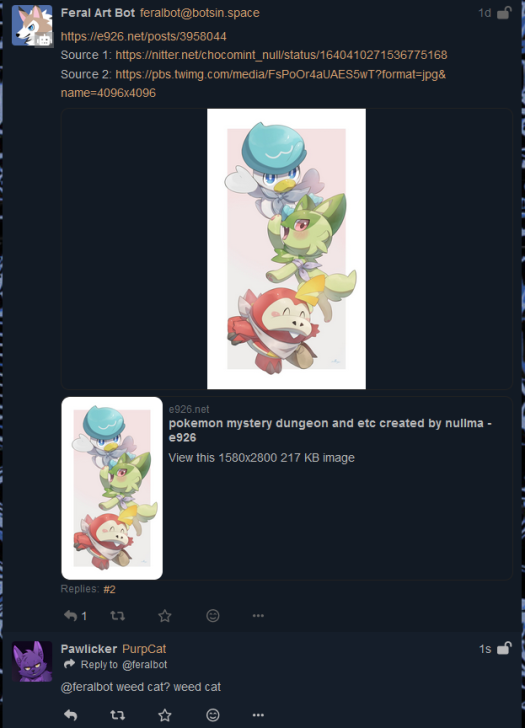
You’ll learn this the hard way because many instances hide their lists.

Much of the developments from this crowd are less about censorship and fake ideas of security, and more about new features. Emoji reacts, quote posting, several attempts at chat functionality, and a functioning search are many features this side of the fedi pioneered or has that Mastodon lacks. People on the Mastodon side are surprised to hear about features Pleroma has, but as a result of the “bad people” using it many will use Akkoma to signal to the crowd (which offers only hugboxing features over mainline Pleroma). It doesn’t matter how much Moon, or Lain, or someone else in the Pleroma circle tries to pander to the transgender community for example. This is exactly how they will forever be seen:

Of course, this kind of thing is protested hard on this side of the fedi too by a few powerusers. The fedi block API script is designed to catalogue blocks from instances that didn’t hide it. Some instances deliberately disable signed fetches to protest the behaviors of instances that abuse this. Another script I can’t find even goes as far as sending fake signed fetches with another domain to bypass the federation issues. Some users take it to the extreme of MRFs that reject deletion requests or that strip away scope info for non-DM posts to protest “lockfags” doing it. There’s even people having too much fun with Mastodon search being hashtag based, by spamming hashtags to absolutely flood the feeds of Mastodon users (if you copy and paste a ton of hashtags and make sure to include both #mutualaid and #fediblock and then just shitpost, you’ll cause chaos. Ask me how I know this.)
There’s of course also drama to be expected with this side; which isn’t unsurprising when people who hate each other and don’t put on the illusion of teaming up are thrown into a room. You can’t be shocked that an Akkoma instance where the owner literally links to a “Gender Acceleration” paper is blocking people on the designated side of the fediverse. But some drama storms like the Alex Gleason drama or Poast deciding who to block just scream “trailer park level drama”, like redneck truckers on a CB radio band accusing each other of being gay. You have no idea where or how the feud started, but they want to beat the fuck out of each other for the purpose of appearing badass or something.
Despite this, this side of the fediverse is nicknamed the “fun side” because it’s the one place the moderators hold no power over online.
The short version
There’s a lot of fault lines you could point at to summarize the difference between each side of the fediverse. There’s signed/authorized fetches vs working normally. There’s software usage. There’s the positions of admins on free speech or trans issues (which 10 years ago might as well have not existed). But in reality, after looking back at both, there’s a very simple dividing line.
One side wants to use the fediverse to escape social media platforms, to post without the fears of moderators against fun or censoring discussion/content.
The other side wants to use the fediverse because they feel that Twitter wasn’t and isn’t censoring hard enough. They want censorship features and features to enable a larger hugbox (see Akkoma’s “bubble”, turning on signed fetches by default, turning off relay functionality by default, etc.) and will try to force everyone around them to do the same.
Only one side will end up sticking with the fediverse because they have nowhere else to go that doesn’t involve subtle behavior modification (see everything YouTubers will do to stay monetized), the other side will leave after another bit of drama and say “oof yikes the admins are heckin problematic”. In the past, users have not been thrilled about the idea the neutered fediverse Mastodon offers, and this has tainted the name of Mastodon heavily. Who knows where the fedi will be in 5 years, but the truth is this is exactly where the dividing line is with the fediverse.
But either way; as a result of all of this there are two massively distinct fediverse userbases and cultures only kept apart by powertripping administrators on the censor happy side who want to make sure that you never see anything bad online ever.
